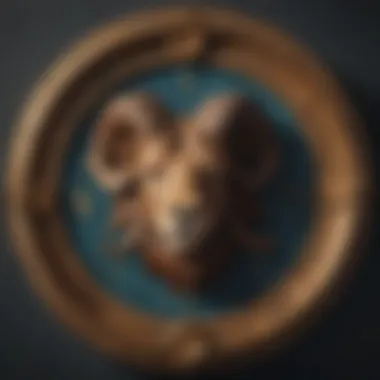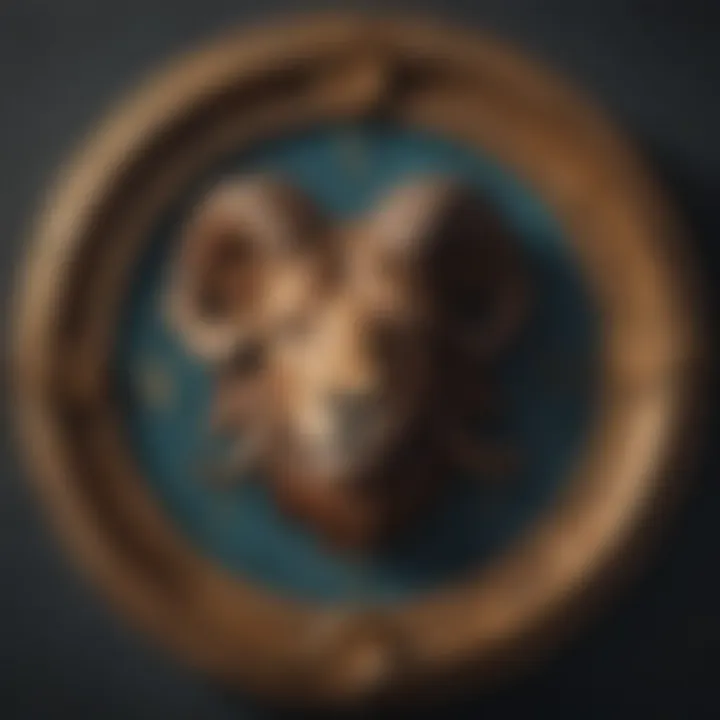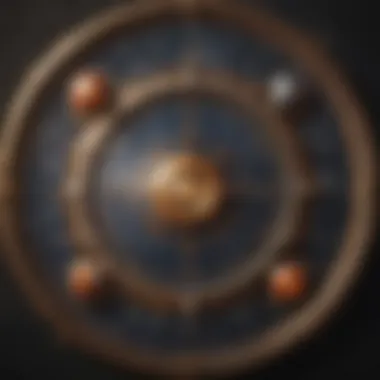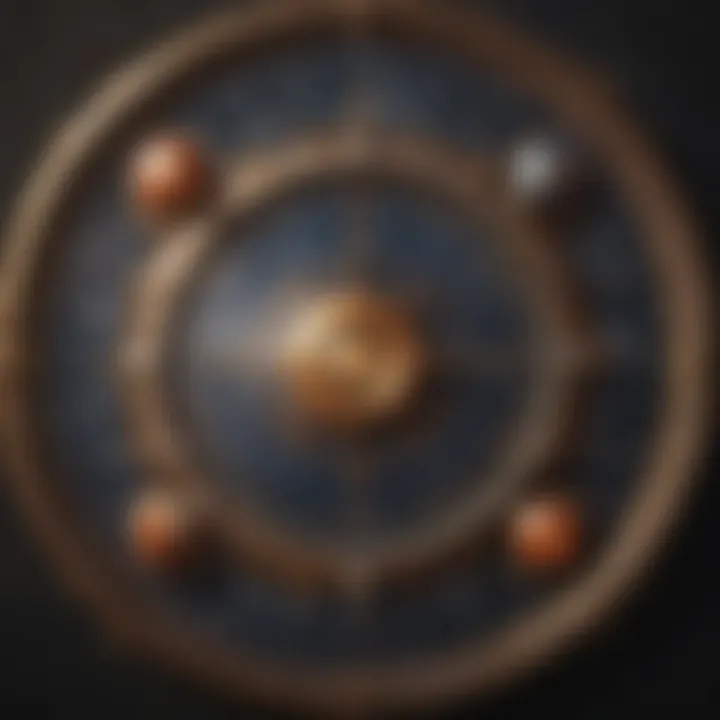Exploring the Depths of Horoscopes and Astrology


Intro
Astrology, with its deep roots and rich tapestry of beliefs, often fascinates individuals seeking meaning beyond the mundane. Sometimes deemed whimsical or ignored as a mere fancy, astrology possesses a complexity that reflects age-old wisdom about human behavior, emotions, and celestial connections. As we embark on this journey through horoscopes, zodiac signs, and tarot readings, we arrive at a multi-layered understanding, one that flows from ancient practices yet correlates with modern psychology.
Understanding the characteristics of each zodiac sign constitutes our first essential step. Not only do these signs provide a vibrant canvas upon which personalities are painted, but they also speak of intrinsic strengths, weaknesses, and potential compatibility with others. A detailed, nuanced comprehension of these characteristics opens doors to personal growth, enhancing self-awareness and guiding interpersonal relationships. Each sign, whether it’s the fearless Aries or the balanced Libra, holds a story—one filled with insights waiting to be discovered.
This narrative blends insights from horoscopes with the art of tarot, creating a holistic approach that can benefit both novices and seasoned astrologers alike. It's not merely about reading the stars; it’s about interpreting their dance and understanding how they influence our lives, relationships, and decisions.
In this article, we’ll dissect these pivotal elements, revealing how they intertwine with the cosmic fabric of existence. So, let’s dive directly into the characteristics of each zodiac sign, sparking our exploration into a world rich with celestial guidance.
Preface to Astrology
Astrology, often seen as a blend of art and science, provides a structured means of interpreting the celestial play. This study of celestial bodies and their supposed influence on human affairs can feel overwhelming but offers a rich tapestry of insights into human behavior and destiny. Understanding astrology lays the groundwork for exploring horoscopes, zodiac signs, and astrological charts.
Astrology not only serves as a communication tool but also as a framework for personal growth. It encourages self-reflection, helping individuals to grasp their strengths and weaknesses. In our increasingly complex world, where information overload is the norm, astrology can provide a sense of order.
Historical Context
The origins of astrology
The roots of astrology stretch deep into history, tracing back to ancient Mesopotamia. This early civilization recognized patterns in the sky, linking celestial events to seasonal changes and farming cycles. This foundation paved the way for astrological practices seen in various cultures, contributing significantly to the knowledge pool that modern astrology stands on.
A defining trait of the origins of astrology is its practice of correlating human experience with the cosmos, which made it a popular choice among ancient societies. They relied on astronomical observations to develop agricultural practices and ceremonies tailored to celestial activities. This unique feature of origins offers both strengths and weaknesses; while providing an ancient lens through which to understand humanity, it may also be perceived as archaic in a world defined by scientific rigor.
Astrology through the ages
Astrology's evolution has seen significant shifts, from being embraced by scholars in ancient Rome and Greece to falling into disrepute during the Enlightenment. Its persistence and revival in modern times signal a profound cultural resilience.
One notable aspect is how astrology adapted to align with the philosophies and beliefs of diverse cultures over history, making astrology a fascinating melting pot. This dynamism contributes to the fluidity of astrological interpretations today. However, its historical baggage can sometimes hinder its acceptance in a more skeptical society.
Cultural influences on astrological practices
Astrology has been shaped significantly by the cultures that embraced it. In Hindu culture, for instance, Vedic astrology places emphasis on the sidereal zodiac, while Western astrology aligns with the tropical zodiac system.
The key characteristic is its adaptability; astrology has integrated elements from different belief systems, enhancing its depth. This blend creates a rich tapestry, allowing for personal interpretations and applications that resonate with followers worldwide. However, this syncretism can lead to confusion; practitioners may struggle with contrasting methodologies that seem diametrically opposed yet stem from similar roots.
Understanding the Basics
Defining astrology and its branches
At its core, astrology is defined as the study that asserts celestial bodies influence earthly affairs. The branches of astrology, including natal astrology, horary astrology, and mundane astrology, provide various lenses through which one can explore this belief.
The key characteristic here is its multifaceted nature; different aspects of astrology appeal to various interests, whether one is focused on personal insight or broader societal trends. This diversity enhances the field's richness, but it can also make it daunting for newcomers to find their footing.
The role of celestial bodies
Celestial bodies—planets, stars, and moons—serve as the primary elements in astrological practice. Their positions at the time of one’s birth create a unique chart, known as a natal chart, which is often seen as a blueprint for personality and potential.
A noticeable feature is how practitioners interpret the influence of these celestial bodies. Each body has its significance, impacting various aspects of life such as emotions, relationships, and career. The challenge here lies in the subjective nature of interpretation; one person’s reading can vastly differ from another’s, which might lead to skepticism among those seeking definitive answers.
Distinction between horoscopes and astrology
Understanding the difference between horoscopes and astrology is crucial for anyone diving into this realm. Astrology encompasses the broader study of celestial influences, while horoscopes serve as practical applications based on specific astrological charts.
A unique advantage of this distinction lies in practicality; while astrology offers deep theoretical insights, horoscopes provide daily or monthly reflections that can be more relatable for the casual reader. However, relying solely on horoscopes without understanding the foundational astrology can lead to misinterpretations or overly simplistic views of life’s complexities.
The Twelve Zodiac Signs
The fascination with the twelve zodiac signs forms a cornerstone of astrology. They are not merely a collection of astrological symbols but denote distinct energies and traits that have been acknowledged across cultures for millennia. By understanding these signs, individuals can gain insights into their personality, relationships, and even future potential. The relevance of zodiac signs lies in their ability to create a personal narrative; they serve as a lens through which we might interpret life events and interpersonal dynamics.
Overview of Zodiac Signs
Preface to the zodiac wheel
The zodiac wheel acts as a map of the sky divided into twelve sections, each corresponding to a zodiac sign. This circular representation mirrors the annual journey of the sun through the cosmos, engaging individuals by visually depicting astrological influences. One of the key characteristics of the zodiac wheel is its cyclical nature. It reminds us that our lives are intertwined with cosmic rhythms.
The benefit of using this wheel is that it simplifies complex astrological concepts, providing a framework for beginners and enthusiasts alike. Furthermore, its unique feature lies in the division of signs into elements and modalities, offering a deeper layer of understanding each sign's influence on our lives. However, some may find themselves overwhelmed by this intricacy when first approaching astrology.
Elements and modalities of zodiac signs
The twelve zodiac signs can be classified into four elements: fire, earth, air, and water. Each element resonates with specific qualities and characteristics. For example, fire signs—like Aries and Leo—are known for their passion and dynamism, while earth signs—such as Taurus and Virgo—exhibit practicality and stability. Understanding these classifications is paramount, as they contribute significantly to one's astrological profile.
One of the key aspects of elements and modalities is their role in shaping personal and collective behavior. They establish the foundation for how signs interact and manifest in the world. The noteworthy feature here is the interaction of various elemental traits that often leads to unexpected dynamics in relationships. While this framework is beneficial for gaining a broader understanding of compatibility, it can sometimes cause confusion in personal interpretations when signs exhibit traits from multiple elements.
Character traits associated with each sign
Each zodiac sign is imbued with specific character traits that influence the behavior of individuals born under that sign. For instance, Scorpios are often described as intense and mysterious, while Libras are recognized for their diplomatic nature. Understanding these traits is not just about knowing oneself but also about embracing the diversity of human experience.
One notable characteristic of these traits is how they provide guidance on personal and professional interactions. For many, this exploration can enhance communication skills and relationship-building opportunities. The unique feature is that these traits serve as a bridge for greater self-awareness. It can be said that familiarity with one's zodiac-related traits can foster personal growth and development, though there can be a tendency to rely too heavily on these definitions, potentially limiting one's understanding of individual nuances.
Zodiac Sign Compatibility
Understanding relationship dynamics
The study of relationship dynamics through the lens of zodiac sign compatibility adds an interesting layer to the exploration of astrology. It raises intriguing questions about how character differences and alignments affect interpersonal connections. One strength of examining these dynamics is that it facilitates a deeper understanding of oneself and others, promoting harmonious interactions. By being aware of how different signs interact, individuals can navigate their relationships with greater awareness.
The key characteristic of this aspect is its ability to help individuals make informed decisions in their personal lives, particularly when it comes to choosing friendships or partnerships. However, there can also be pitfalls; trusting compatibility too rigidly can lead to overlooking personal chemistry.


Elements of compatibility analysis
Compatibility analysis primarily considers elements, aspects, and personality traits of each zodiac, offering a structured approach to assess relationship potential. Fire signs, for example, may find ease with other fire or air signs due to their complementary natures, while earth signs often resonate with other earth or water signs based on their practical approach to life.
This analysis is beneficial as it provides individuals with a foundation on which they can build their understanding of interpersonal interactions. However, the unique feature of compatibility analysis also lies in its limitations. While this framework can be useful, it might fall short in accounting for individual differences and personal circumstances, showing that compatibility is not solely dictated by astrology.
Challenges and opportunities in connections
Lastly, challenges and opportunities in connections arise through zodiac exploration. Each sign brings a unique set of strengths and weaknesses to any relationship, creating a vibrant yet complex interplay. For instance, a fiery Aries might clash with a sensitive Cancer, but such differences can also provide opportunities for growth and insight, highlighting how individuals can learn from one another.
One notable aspect of this discussion is the opportunity for personal development that arises when individuals encounter contrasting signs. Recognizing challenges can often foster resilience and patience. Nevertheless, acknowledging these hurdles can occasionally lead to frustration, particularly if one feels strongly about astrological influences on their relationships. Thus, it’s vital to approach these dynamics with flexibility and openness, understanding that astrology is but one part of the broader human experience.
Horoscopes: Daily Life Reflections
Horoscopes play a pivotal role in the realm of astrology, resonating deeply within daily life. They offer insights and guidance, acting as a compass, steering individuals through the complexities of their day-to-day experiences. People often look to horoscopes not just for whimsical predictions but for meaningful reflections that can illuminate their choices and moods. This section aims to explore the different types of horoscopes and how they can be effectively crafted to enhance personal understanding and growth.
Types of Horoscopes
Daily, weekly, and monthly horoscopes
Daily, weekly, and monthly horoscopes serve varied purposes, capturing the essence of astrological shifts. Daily horoscopes are akin to a morning cup of coffee; they provide a quick jolt of guidance for the day ahead.
- Key Characteristic: Daily horoscopes focus on immediate influences and challenges, helping individuals navigate through immediate decisions.
- Why Beneficial: This format is popular as it fosters a routine, providing a daily moment of reflection. Many find that these horoscopes offer a sense of connection to celestial rhythms.
- Unique Feature: Their timeliness allows for immediate application, but they can sometimes feel superficial, omitting the bigger picture. Weekly horoscopes offer a broader view, weaving together themes that may shape one’s week—like a tapestry made of threads spun from the stars. Monthly horoscopes, meanwhile, encourage contemplation of larger cycles, highlighting significant shifts that require more time to manifest.
Personal versus general horoscopes
Personal horoscopes delve deeply into an individual’s unique birth chart, offering tailored insights that resonate more closely with specific life circumstances. Conversely, general horoscopes provide a snapshot for a broader audience, focusing on collective themes based on zodiac signs.
- Key Characteristic: Personal horoscopes incorporate exact birth dates, times, and locations—offering really tailored insights. General horoscopes, while broader, create a sense of community.
- Why Beneficial: Many gravitate towards personal horoscopes for their depth and specificity. General horoscopes can serve as an entry point for newcomers, allowing them to explore their astrological identity without overwhelming details.
- Unique Feature: While personal horoscopes can be quite enlightening, they often require more effort to interpret and may not be as easily accessible as general horoscopes.
Astrological transits and their influences
Astrological transits refer to the movement of planets through the zodiac and the subsequent influence they exert over individuals. These transits can have profound implications, revealing opportunities and obstacles that one might expect in life.
- Key Characteristic: The changing positions of planets impact personal charts, influencing moods, relationships, and events.
- Why Beneficial: Understanding these transits can offer insights into timing for significant decisions or actions, allowing individuals to align with cosmic momentum rather than swim against the tide.
- Unique Feature: While focusing on transits may uncover powerful insights, it requires studying the sky more intently, which can seem intimidating to beginners.
Crafting an Effective Horoscope
Crafting an effective horoscope centers around the interpretation of complex astrological information into relatable guidance. This section emphasizes the need for accurate birth data, the knowledge of reading and interpreting charts, and addressing common myths surrounding horoscopic predictions.
The importance of accurate birth data
Accurate birth data is the cornerstone of crafting reliable horoscopes. Knowing the precise time, date, and location of birth ensures that the astrological chart reflects the unique circumstances surrounding an individual’s entrance into life.
- Key Characteristic: Birth data sets up the personalized nature of a horoscope, shaping its interpretations.
- Why Beneficial: This personalization enhances the effectiveness and relevancy of astrological insights, allowing them to resonate more profoundly with one’s life experiences.
- Unique Feature: While detailed and specific, acquiring accurate birth data can be challenging for those unfamiliar with its significance.
Reading and interpreting charts
The skill of reading and interpreting astrological charts is an art form that blends intuition with technical knowledge. Charts reveal the connection of celestial bodies to individual lives, meriting careful attention to patterns.
- Key Characteristic: Understanding symbols, houses, and aspects in charts offers deep insight into personality, events, and growth opportunities.
- Why Beneficial: Chart interpretation empowers individuals to navigate their life paths consciously, embracing challenges as growth opportunities.
- Unique Feature: While rewarding, interpretation can be intricate and overwhelming for beginners, often requiring mentorship or dedicated study.
Myths surrounding horoscopic predictions
Myths often cloud the understanding of horoscopes, leading to misconceptions about what astrology can and cannot do.
- Key Characteristic: Such myths may include over-generalization that horoscopes always predict a specific outcome.
- Why Beneficial: Debunking these myths helps in cultivating faith in astrology grounded in reality rather than fantasy, encouraging individuals to appreciate its nuances.
- Unique Feature: Addressing these myths is crucial, but can also lead to resistance from skeptics who may dismiss the validity of astrological practice.
The exploration of horoscopes illuminates their impact on daily reflections and decisions. By understanding their types, crafting them effectively, and discerning accuracy, individuals can make more informed personal choices as guided by the stars.
Astrological Charts and Their Significance
Astrological charts serve as the foundation for interpreting the influence of celestial bodies on human lives. Unlike mere horoscopes which are limited to daily predictions, these charts provide a detailed map of where planets were positioned at the exact moment of a person’s birth. This plays an essential role in shaping one’s personality, relationships, and life experiences. For any practitioner or enthusiast, understanding the depth of these charts is crucial for providing meaningful insights. They reveal patterns, challenges, and opportunities, making them indispensable tools in astrology.
Materializing the Natal Chart
Components of a natal chart
Discussing the components of a natal chart, we highlight elements like the Sun, Moon, and Ascendant. Each of these components reflects different facets of a person's identity. The Sun might signify core essence and vitality, while the Moon captures emotional patterns, and the Ascendant indicates how one presents to the world. What makes them stand out is their ability to combine into a coherent picture of an individual’s psyche. This multidimensional aspect makes natal charts a beneficial choice for those seeking a comprehensive understanding of themselves or others. Moreover, these components can distinctly influence how individuals navigate life's challenges.
Understanding houses in astrology
The houses in astrology correspond to various life experiences, from relationships to career choices. Each house represents a different arena of life where planetary influences can manifest. For instance, the 7th house pertains to partnerships and marriage, while the 10th house denotes career and public image. This systemic organization gives clarity and focus to an astrological interpretation. Understanding the different houses allows astrologers to pinpoint areas that may require attention or offer potential. Such specificity can guide individuals looking to delve deeper into their personal development and healing journeys. However, navigating these houses can also come with complexities; one misinterpreted aspect could skew one’s understanding.
Influence of planetary positions
Planetary positions at the time of birth affect a chart dynamically, laying the groundwork for potential traits and life paths. For instance, a well-aspected Venus could suggest harmony in relationships, while a strained Mars might lead to impulsiveness. Each planet embodies distinct energies, influencing various aspects of life. This facet of astrological charts is crucial because it provides insights into behavioral patterns that might otherwise remain hidden. It proves beneficial for understanding personal struggles and enhancing self-awareness. However, while beneficial, the interpretation of these positions can also lead to a deterministic viewpoint if not wielded with care, inflating potential anxieties or fears.
Transits and Progressions
How transits affect natal charts
Transits refer to the current movement of planets in relation to the natal chart, and they can shape experiences and opportunities in an individual’s life. A major transit may signify a period of change or growth; for instance, a Saturn return often marks a pivotal time of maturation. Astrologers thus note how these transits impact the natal chart, offering personal growth insights. This ongoing relationship between the planets and natal charts keeps astrology relevant and dynamic, enabling individuals to adapt and plan for forthcoming challenges. However, people sometimes perceive these transits as ominous warnings rather than natural phases of life.
Progressions and personal development
Progressions take a more internal view by advancing the natal chart forward in time. Essentially, a day after birth is equated to a year of life. Therefore, each progression provides a lens into evolving aspects of personality and life situations. By examining these progressions, one can gain clarity about internal shifts and objectives. This nuance becomes a valuable tool for personal development, allowing individuals to align their goals with their inner motivations and emotional state. However, it can introduce a sense of urgency, leaving individuals feeling pressured to achieve certain milestones within specified timeframes.
Key planetary movements to note


Focusing on planetary movements that bear significant weight in astrological practice is vital. For example, major alignments or shifts like Jupiter entering a new sign bring distinct opportunities, while eclipses symbolize endings and new beginnings. Recognizing these movements helps individuals anticipate shifts in energy and prepare for the eventual impact. Furthermore, insightful attention to these key movements can encourage proactivity, fostering an overall sense of empowerment. Yet, ignoring the nuances of these movements may lead to misunderstandings or missed opportunities.
"Astrology isn’t about fortune-telling; it’s about understanding the patterns and cycles that influence our lives."
In summary, the significance of astrological charts encompasses a thorough understanding of individual complexities and personal growth opportunities. The components of a natal chart, the arrangement of houses, the influence of planetary positions, and the interaction with transits and progressions collectively inform a complete understanding of an individual’s celestial blueprint.
Tarot: An Extension of Astrological Insight
Tarot has emerged as a fascinating companion to astrology, providing a multidimensional framework for understanding the self and the universe. Both systems, while unique, share a common thread—an exploration of subtler energies that shape human experiences. By intersecting tarot with astrological insights, practitioners can enrich their interpretations and foster deeper self-reflection. In this section, we delve into the intertwining nature of tarot and astrology, highlighting their synergies and the invaluable insights that arise from this blend.
The Relationship between Astrology and Tarot
Correspondences between tarot cards and zodiac signs
The relationship between tarot cards and zodiac signs bears significant relevance. Each of the twelve zodiac signs has distinct traits, and these align with particular tarot cards, making the correspondences dynamic. For example, the Moon card resonates with Pisces, capturing its intuitive and emotional essence, while the Emperor card embodies the authoritative nature of Aries. This parallelism offers a layered approach to understanding personalities and situations—providing a lens through which we can view both astrological influences and tarot symbolism.
The key characteristic of these correspondences is their ability to offer guidance tailored to an individual’s zodiac sign. When used thoughtfully, they can create powerful narratives that illuminate one’s path. However, it’s important to be aware that these connections can also introduce complexity. Some practitioners may find it challenging to see beyond common interpretations of either cards or signs, potentially skipping over deeper meanings.
Integrating tarot in astrological readings
Integrating tarot into astrological readings opens new avenues of insight. Astrologers can ask specific questions related to planetary influences, and draw cards to gain perspective on particular situations or decisions. This method adds depth, allowing a more nuanced interpretation of astrological positions. An obvious advantage is the ability to visually represent abstract astrological concepts through the imagery and symbolism of the tarot. Each reading encapsulates stories that guide the querent through emotional and spiritual landscapes.
Nonetheless, the integration must be approached cautiously. There exists a risk of conflating the two systems. For a reading to remain coherent, it’s vital to maintain clarity about which tool is informing which insight. Otherwise, one may find themselves in a muddled mess of interpretations.
The role of intuition in tarot
Intuition in tarot plays a crucial role, acting as an internal compass during readings. While spreads may provide structure, the real magic happens when intuitive insights leap to the forefront. Interpretive messages form fluidly as readers work with their instincts to guide their analysis. This key aspect can often lead to profound revelations—moments when cards resonate deeply with the reader or the querent’s life experience.
The uniqueness of tapping into intuition lies in its personal connection to the reader. Each interpretation may differ greatly amongst tarot practitioners, leading to diverse insights. While this subjectivity enriches the reading process, it can also present challenges in conveying consistent messages across different readings. Readers should aim for balance between their intuition and established meanings to create informed, grounded interpretations.
Tarot Card Spreads
Common tarot spreads for insight
Common tarot spreads serve as foundational tools for insight, ranging from simple three-card spreads to more elaborate Celtic Cross layouts. These configurations provide a structured way to explore aspects of life such as love, career, or decision-making. For instance, a three-card past-present-future spread offers a quick snapshot of how past events influence current situations and future developments.
The pivotal characteristic of these spreads lies in their versatility. Different layouts can adapt to various questions and contexts, enhancing the user’s experience. However, one disadvantage might be that an overly complex spread could confuse beginners, leading them to misinterpret card positions or meanings.
Interpreting card positions
Interpreting card positions is integral for deriving focused relevance from a spread. Each position imbues cards with specific meanings based on their location. For example, the first card in a spread might reflect past influences while the last card could hint at future possibilities. This positional meaning empowers readers to derive coherent narratives from a seemingly random draw of cards.
What’s key here is consistency in one’s interpretative process. Beginners should familiarize themselves with common meanings associated with various positions to create structured readings. Yet, relying too heavily on rigid positional meanings might limit the reader’s intuitive flow altogether, thus stifling their creativity and adaptability.
Tips for conducting a tarot reading
Conducting a tarot reading requires a blend of preparation and openness. Here are a few tips to enhance the process:
- Create a calm environment free from distractions.
- Clearly define the purpose of the reading to focus the inquiry.
- Approach each card with a fresh perspective, allowing room for intuitive messages.
The key characteristic of these tips is that they help establish a conducive setting for insightful readings. By emphasizing mental clarity and emotional preparedness, readers maximize their potential for meaningful interactions with the cards. However, there exists a risk of over-preparation. Focusing too intently on rituals may detract from the authentic, spontaneous interpretation that tarot often thrives on.
In essence, tarots and astrology complement each other beautifully, enriching the inquiry and deepening self-awareness. As practitioners navigate both systems, they unlock invaluable wisdom, integrating these cosmic tools with intention and clarity.
Celestial Events Impacting Astrology
Celestial events play a crucial role in the astrological landscape, shaping how practitioners interpret influences from the universe. These occurrences, whether they be eclipses, retrogrades, or unique planetary alignments, serve as significant markers in the astrological calendar. Their effects resonate throughout various astrological practices, affecting personal horoscopes and broader trends.
Astrologers recognize that when certain celestial events take place, they may bring about shifts that individuals can feel on a personal level. Understanding these movements can offer insight into one's life path, promote self-awareness, and help in navigating the often turbulent waters of existence. Moreover, discerning these astrological signals can enhance the effectiveness of any horoscope reading.
Understanding Eclipses and Retrogrades
Significance of Solar and Lunar Eclipses
Eclipses mark pivotal turning points in astrology. A solar eclipse may usher in opportunities for new beginnings, acting like a cosmic reset button. Contrarily, lunar eclipses often signify the culmination of ongoing themes in one’s life, pressing individuals to let go of what no longer serves them.
One key characteristic of eclipses is their tendency to reveal hidden aspects of ourselves or our situations. Solar eclipses encourage fresh starts, while lunar eclipses can generate a moment of reckoning. This duality provides a balanced lens through which to understand shifts in personal development.
The distinctive feature of eclipses is their rarity. Most astrological calendars highlight them, drawing attention to their implications, which can be both empowering and daunting. Practitioners may benefit from integrating eclipse periods into their life planning, though they should also be wary of the potential emotional upheaval associated with these events.
Mercury Retrograde: Myth vs Reality
The infamous Mercury retrograde has garnered a reputation steeped in mythos. Many believe that communication breakdowns, technology glitches, and travel mishaps become rampant during this phase. However, the reality is a bit more nuanced. Yes, misunderstandings may flare up, but this period also provides an opportunity for reflection and reassessment.
The most notable characteristic of this phenomenon is the illusion of Mercury moving backward in the sky. This period encourages individuals to revisit unfinished business, allowing for clearer insights into past decisions.
What sets Mercury retrograde apart is its connection with personal growth. While it may seem disadvantageous, it prompts a pause that can catalyze deeper understanding. Learning to navigate this time effectively can be quite beneficial, transforming potential chaos into clarity.
Strategies for Navigating Challenging Phases
Having strategies in place for difficult astrological events, such as eclipses and retrogrades, can help mitigate their challenges. Being prepared can turn obstacles into opportunities for growth. One core strategy includes practicing patience and mindfulness during these periods. Recognizing that discomfort often precedes clarity can encourage individuals to lean into uncertainty rather than resist it.
Highlighting the significance of adaptability, those ready for change can find unexpected pathways. This notion underlines the importance of setting intentions ahead of critical celestial events.
The unique feature of these strategies lies in their practicality. Simple approaches, like journaling thoughts during these cosmic shifts or practicing meditation, can prove immensely beneficial, offering a form of emotional grounding. Following these methods can soften the impact of challenges faced during celestial phenomena.
The Role of Planetary Alignments


Effects of Planetary Transits
Planetary transits are when planets move into different zodiac signs, and their effects can be profound. They influence our emotions, decision-making, and even interpersonal relationships. Each planet carries its vibes, and its position can alter how these energies manifest in our lives.
One remarkable characteristic of planetary transits is their timed cyclical nature. This predictability allows astrologers to make informed interpretations about upcoming influences.
The benefit of understanding these transits is twofold: it helps people prepare for energetic shifts and allows them to recognize timing for actions that correspond with specific planetary influences.
Stellar Conjunctions and Their Implications
When two or more planets align in the sky, this is known as a stellar conjunction. The convergence of energies from different celestial bodies can create potent combinations that shape experiences, especially for those whose natal charts are impacted by such alignments.
The key characteristic of conjunctions is their amplified effect; these meeting points create heightened energies, producing outcomes that can be either harmonious or challenging. This feature means that knowing when conjunctions will happen can be pivotal in planning significant life changes or decisions.
Understanding the implications of these celestial connections can foster a deeper connection with oneself and one's environment. They deliver insights into the paths we take, acting as road signs in life.
Charting the Effects of Rare Astrological Events
Some astrological events are so rare that their implications last a lifetime. Charting these occurrences allows practitioners to glean insights from their influences. Events such as the Saturn return or rare planetary alignments can signal significant times for growth and reflection.
The unique aspect of these rare events is their impact often reverberates through different house placements in the natal chart, influencing various life areas. This trait can lead to momentous changes, pushing individuals toward their highest potential.
The advantage of tracking these rare occurrences lies in their predictability. Engaging with these celestial events carefully can lead to newfound clarity about one's life purpose, shedding light on areas requiring attention.
Understanding and leveraging celestial events empowers individuals, fostering personal development through the cosmic rhythms that surround them.
Psychological Aspects of Astrology
Astrology, often criticized as mere superstition, holds a considerable place in the psyche of many individuals. This section sheds light on how astrology isn't just about celestial placements; it's a mirror reflecting human psychology, beliefs, and aspirations. The psychological aspects relate heavily to how individuals interpret their lives and the meanings they attribute to the cosmos above.
Belief Systems and Astrology
How beliefs shape interpretations
Beliefs are like the lens through which we perceive the world, and in astrology, they significantly shape how people interpret their horoscopes. If someone believes strongly in their zodiac sign, they might see their life events—both good and bad—as reflections of astrological influences. This symbiotic relationship between belief and interpretation further enriches the astrological experience, giving individuals a sense of control and understanding over life events that may seem chaotic.
What sets this interpretation approach apart is its adaptability. One's beliefs can shift based on personal experiences, leading to different interpretations at different life stages. This adaptability makes astrology a compelling and flexible tool. However, relying too heavily on these beliefs may lead to confirmation biases, where individuals only notice the instances that validate their existing beliefs while ignoring contradictory evidence.
Psychological motivations behind astrology
Why do people turn to astrology? The motivations are deeply rooted in psychological needs. For many, astrology serves as a refuge during turbulent times, acting as a guide to navigate life's uncertainties. When one faces challenges, finding solace in the belief that celestial bodies influence their path can be comforting.
The key characteristic here is the reassurance provided. It offers a psychological safety net during times of indecision or crisis. However, it can also open the door to reliance on external factors rather than fostering personal responsibility for one's choices. This duality of motivation creates a unique landscape—one of empowerment tinged with a potential for dependency.
The cognitive dissonance of faith in astrology
Cognitive dissonance occurs when one’s beliefs clash with reality. In astrology, this might manifest when someone's predictions do not come true, leading to inner turmoil. They might grapple with the idea that they believed in astrology or doubted its validity. This aspect of psychological conflict can create a fascinating interplay for those devoted to the practice.
What's compelling here is that despite experiencing dissonance, many people find ways to reconcile it. They might blame external factors or revise their interpretations to soothe their inner conflict. This trait highlights the resilience of belief systems. However, it also begs the question: when does belief assist in coping, and when does it restrict growth?
Astrology and Personal Growth
Astrology undoubtedly extends beyond celestial charts; it can act as a profound tool for personal growth. By engaging with one’s astrological data, individuals can foster a deeper understanding of themselves.
Using astrology for self-reflection
Astrology invites individuals to ponder their inner selves. By examining their birth charts, people engage in introspection—a practice increasingly vital in today’s fast-paced world. This reflective tool fosters a space where one can assess strengths and weaknesses.
The beneficial aspect of self-reflection through astrology is often the clarity it provides. However, the downside is that it can lead to over-analysis, where one might dwell too deeply on minor astrological placements, missing the larger picture of their life experience.
Astrological charts as mirrors of the self
Each astrological chart represents a unique blueprint of an individual’s personality and potential. This blueprint reflects not only their traits but also patterns in behavior and relationship dynamics. Understanding these attributes can empower individuals to harness their strengths while acknowledging their limitations.
The unique feature of astrological charts is their ability to provide a holistic view of the self. People often find value in knowing how different astrological elements interact. Yet, there’s a downside: charts can sometimes box individuals into fixed notions of who they are, potentially stifling personal growth.
Integrating astrology as a tool for life planning
Integrating astrology into daily life provides a framework for planning and decision-making. It helps individuals align their intentions with favorable celestial timing, enhancing chances for success in various endeavors. This cosmic alignment offers a unique perspective to approach personal goals with clarity.
What makes this integration popular is its historical significance—many cultures have relied on astrological timing for significant decisions, like marriage or investment. Nonetheless, depending too heavily on astrology for planning can lead to misplaced agency—where individuals may wait for the right transit instead of acting on their own accord.
"Astrology does more than predict outcomes; it provides a lens to understand oneself and the universe, shaping our choices and paths in ways we might not fully comprehend."
Finale
The culmination of our examination into horoscopes and astrology underscores the timeless relevance of these ancient practices. As we stand at the intersection of tradition and modernity, it's clear that astrology offers not merely predictions, but a framework for understanding oneself and the world.
The Ever-Evolving Field of Astrology
Future trends in astrological practices
One notable trend in today's astrological practices is the increasing integration of technology. Astrologers harness software not only for calculations but also for generating personalized reports that resonate with individuals' life experiences. This proficiency in utilizing tech isn't just a passing fad; it reflects a shift towards accessibility. No longer do enthusiasts have to wander blindly through the stars; they find guidance with tools available at their fingertips.
Despite potential downsides, like over-reliance on automated readings, the detailed reports offer an enriching perspective into their unique charts.
Embracing a holistic understanding of the cosmos
Astrology has shifted from a simplisitic view to a more comprehensive vision involving psychology, mythology, and even spirituality. Understanding the cosmos holistically means not confining oneself to mere sun-sign interpretations. This broader comprehension embraces various celestial influences and integrates them into a rich tapestry of understanding, aiding personal evolution.
Such a perspective is gaining traction as more individuals seek depth in their readings, turning to astrologers who provide nuanced insights. While this expansion can lead to complex interpretations, it also opens doors for profound self-exploration and connectivity with the universe.
Final thoughts on the integration of astrology in everyday life
Lastly, the incorporation of astrology into daily routines has become mainstream, serving as both a guide and a companion. Activities as simple as reviewing daily horoscopes or checking lunar phases can foster mindfulness. This is a significant aspect of contemporary life, where individuals desire understanding amidst chaos.
This ongoing connection reinforces the notion that astrology is not merely an ancient artifact, but a dynamic practice that can positively affect decision-making and self-awareness. While it invites skeptics, the loyal following speaks volumes about its lasting allure and practical value.
"Astrology is just a tool, but how you use it can change the trajectory of your journey."
All things considered, this exploration reveals that astrology, in its many forms, is not only an avenue for insight but also a catalyst for personal growth, paving the way for a more conscious engagement with both ourselves and our surroundings.







